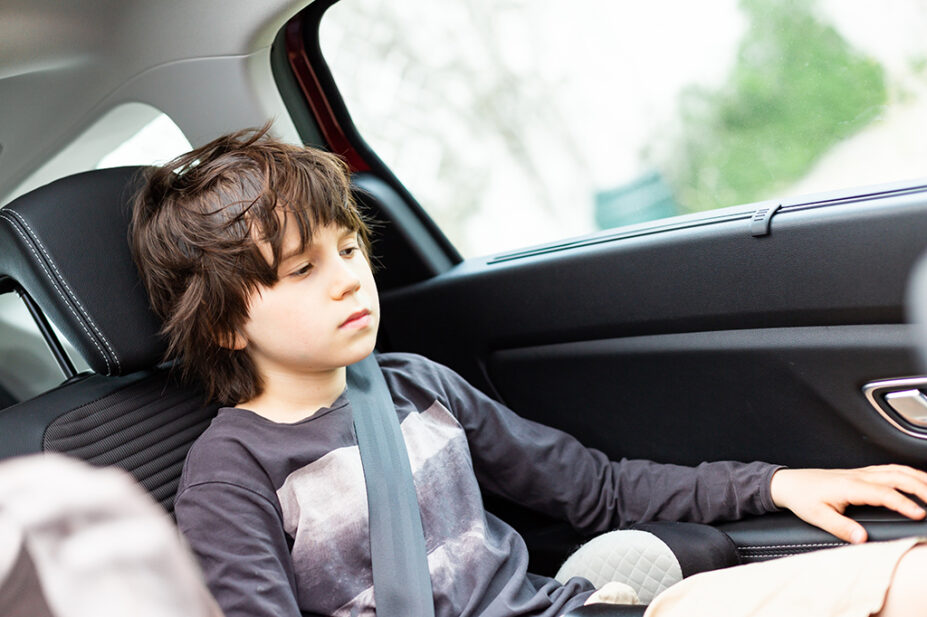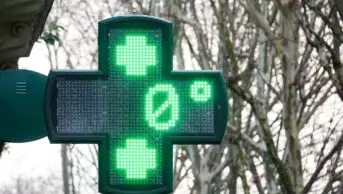
Shutterstock.com
After reading this article, you should be able to:
- Understand the underlying causes of motion sickness and the physiological mechanisms involved in its development;
- Identify risk factors associated with motion sickness and the incidence of this condition in different populations;
- Learn about behavioural and non-pharmacological interventions that can help prevent and manage motion sickness, including dietary changes and relaxation techniques;
- Become familiar with the pharmacological treatment options for motion sickness and different drug classes that are used for this purpose, including antihistamines and anticholinergics.
Introduction
Motion sickness, also known as travel sickness or kinetosis, is a common and complex problem that occurs when there is a conflict between the vestibular, visual and proprioceptive systems, which control balance and spatial orientation[1]. It is thought that 90% of people will experience motion sickness at some point in their lives, although the incidence and prevalence can vary significantly depending on the mode of transport, individuals’ susceptibility and factors such as age and gender[2]. The symptoms of motion sickness can be debilitating and can significantly impact the quality of life of the affected individual. It is, however, a largely manageable or preventable condition.
This article will explore the causes and symptoms of motion sickness, as well as the incidence and risk factors associated with the condition. It will also discuss the management strategies and treatment options available to people who suffer from this condition.
Causes of motion sickness
Motion sickness is caused by a conflict between the sensory input from the eyes, ears and muscles[3]. The vestibular system, located in the inner ear, plays a critical role in maintaining balance and spatial orientation[4]. When there is a discrepancy between the information received by the eyes and the inner ear, the brain interprets this as motion and triggers a response that can lead to nausea, vomiting and other symptoms. An example of this would be a person reading while travelling in a car — their eyes see the stationary book, yet the vestibular system detects the motion of the car[5]. It is commonly encountered in travel by car, sea and air, and also experienced as a result of immersive virtual reality[6].
Motion sickness is not a new phenomenon, with the earliest recorded descriptions dating back to the ancient Greek physician Hippocrates[7]. There are reports of motion sickness caused by horseback riding in early military battles, seasick sailors during the voyages of discovery, and air sick pilots during World War II[8]. Despite its long-standing prevalence, the impact of motion sickness on daily life has not been extensively studied[9].
Motion sickness is typically managed in the community setting, meaning pharmacists can play an important role in identifying patients at risk and providing appropriate treatment and support to help manage symptoms.
Incidence and risk factors
The incidence of motion sickness varies greatly, depending on the magnitude of the stimulus and the susceptibility of the individual[10].
When managing motion sickness, healthcare professionals should consider the following risk factors:
- Age — motion sickness is more common in children and young adults. It is rare in children aged under two years and said to peak between the ages of 3 years and 12 years[9,10]. The reason for motion sickness peaking between these ages is not entirely understood, although one theory is that the vestibular system is still developing at this age; therefore, children are still learning how to integrate and interpret different types of sensory information. Adults aged over 50 years are less likely to experience motion sickness owing to age-related changes in the vestibular system[10].
- Medical history — patients with inner ear disorders, such as Ménière’s disease or those who have a history of migraines, are more susceptible to motion sickness[3,9]. Patients who have a history of motion sickness are likely to experience more severe symptoms in the future following repeated exposure to motion. It is also more common in patients who suffer from cardiovascular diseases, such as hypertension or coronary artery disease; respiratory conditions, such as asthma and COPD; or gastrointestinal issues, such as gastroesophageal reflex disorder or irritable bowel syndrome.
- Sex — females and pregnant women more commonly experience motion sickness than men. A 5:3 female-to-male ratio for vomiting has been shown in ferry passengers[11,12].
- Mode of transportation — this can often have an impact on the severity of the sickness. It can be more common on a plane during turbulence or when travelling in rough seas.
- Other medications — some medications worsen a patient’s symptoms of motion sickness[13]. Some antidepressant medication, such as selective serotonin reuptake inhibitors, tricyclic antidepressants and monoamine oxidase inhibitors can cause dizziness and nausea, which can worsen motion sickness symptoms. Blood pressure medications, such as alpha blockers and calcium channel blockers, can also cause dizziness[13].
- Smoking — smokers are more susceptible to motion sickness when at their accustomed level of tobacco use than when they are nicotine deprived[14].
Symptoms
The common symptoms of motion sickness include nausea, vomiting, sweating, dizziness and general inability to function[6,9]. Some people may also experience loss of appetite, headaches and fatigue[6]. The symptoms of motion sickness can vary from person to person. Some individuals may only experience mild symptoms while others may experience more severe symptoms.
In most cases, vomiting is almost inevitable, even if the patient is removed from the environment. Vomiting usually provides some temporary symptom relief[9]. Symptoms are also generally divided into central nervous system and autonomic symptoms[13]. Examples of each can be seen in Table 1[2].
Management strategies and treatment options
Preventative measures
The obvious solution to preventing motion sickness is to avoid situations that may trigger the symptoms. However, this is not always realistic. If a journey cannot be avoided or stopped, behavioural measures and medications are useful.
Prevention of motion sickness is more effective than treating symptoms after they have occurred. Patients should learn to identify situations that may cause motion sickness and take measures to prevent or minimise symptoms[9].
Choice of treatment is determined by the individual patient’s characteristics and the potential severity and duration of the journey[9].
Behavioural prevention
If a patient is unable to avoid a situation that is likely to cause motion sickness, there are several effective behavioural countermeasures. These include:
- Habituation programme — this is a process by which a person is gradually exposed to continuous or repeated motion sickness triggers, with the idea that the body becomes desensitised to the specific triggers. Habituation is the most effective non-pharmacological treatment and most people, in time, will notice a reduction in symptoms. These programmes are typically used by people who are frequently exposed to motion sickness for work and referral pathways will vary. They can be time-consuming and may not be practical for managing infrequent motion sickness, but they are an effective treatment option if motion sickness is significantly affecting the person’s quality of life or capacity to perform their job[15,16].
- Minimising vestibular motion — patients should avoid travelling in bad weather conditions and, if possible, choose a mode of transport less likely to cause symptoms. If they must travel, they should try to sit in the part of the vehicle with the least amount of movement. For example, driving or sitting in the front seat if travelling by car, sitting over the wing of an aircraft if flying, or choosing a place that is as close to the water level as possible and in the centre, if travelling by boat (see Box)[9,16].
- Reducing sensory input — this may be helped by lying down, closing the eyes, sleeping and avoiding nausea-inducing stimuli, such as noxious odours. Looking at a stable visual reference point, such as the horizon, can help provide a frame-of-reference that allows the visual system to synchronise with the perceived motion. Activities, such as reading or focusing on screens, when travelling should also be avoided as they can enhance visual-vestibular conflict that can provoke and enhance symptoms[9].
- Staying well hydrated — dehydration can worsen symptoms of motion sickness. Patients should stay hydrated by drinking water and limiting alcoholic and caffeinated drinks[6].
- Avoiding smoking — even short-term cessation reduces susceptibility to motion sickness[15].
- Using distractions — controlled breathing, listening to music or using aromatherapy scents, such as mint or lavender, may also help. Anxiety enhances motion sickness; the use of distractions may help to reduce it[6,9].
- Alternative treatments — there are claims that acupressure bands work to prevent motion sickness by applying pressure to a particular point between the two tendons on the inside of the wrist, although there is very little evidence to support their use. Ginger supplements have long been used to prevent and treat nausea, although again there is inconsistent data to support its effectiveness. Patients who prefer to avoid medications and the potential side effects, such as drivers or pregnant women, may be drawn to these types of alternative therapies[1,9,11].
Box: Tips for patients to reduce the effects of motion
- Cars: drive or sit in the front passenger’s seat;
- Planes: sit over the front edge of a wing;
- Ships: sit in the middle, close to the water level;
- Avoid rear-facing seats in any form of transport;
- Focus on stationary objects, such as the horizon;
- Avoid alcohol and heavy, greasy meals before travelling;
- Avoid reading or focusing on screens;
- Ensure there is ventilation, either from an open window or air-conditioning[6,9,17].
Secondary prevention
If symptoms are severe or persist despite behavioural changes, medications may be recommended for occasional motion sickness in those known to be susceptible.
Pharmacological treatment is most effective, when combined with behavioural strategies and given before the onset of symptoms. Gastric stasis occurs with motion sickness, which can slow down drug absorption, so medication should be taken before exposure (see Table 1)[1,7,9].
Drug treatment should be used carefully in patients attempting habituation programmes, since some medications, such as the anticholinergic hyoscine, may delay habituation, either directly or indirectly via sedative effects[9,15].
The drugs currently recommended to prevent motion sickness include antimuscarinics and first-generation (non-selective) H1 antihistamines. Product selection should be based on an individual and the length of the journey should match the duration of action of each medicine (see Table 2 for more information)[18–22].
Pharmacists should enquire about any treatments used in the past for motion sickness and their level of success or failure. Treatment should be tailored to the individual patient, considering factors such as the desirability of sedation. Hyoscine may be recommended for shorter journeys up to four hours, cinnarizine for journeys more than four hours but less than eight hours, and promethazine for journeys longer than eight hours.
Patients should be informed about possible side effects, such as drowsiness, and warned to avoid alcohol owing to increased drowsiness and instructed to not drive or operate machinery. Pharmacists should also enquire about existing medications that the patient may be taking owing to the potential for drug interactions and enhanced adverse effects.
Anticholinergics
Hyoscine is the only anticholinergic indicated for the prevention of motion sickness and is the first-line treatment option in adults. It is widely considered to be superior to antihistamines in managing the condition, although a Cochrane review of 14 randomised controlled trials found it to be no more effective[23].
Hyoscine hydrobromide competitively inhibits the actions of acetylcysteine at the muscarinic receptors of autonomic effector sites innervated by parasympathetic nerves. It has a central and a peripheral action, as it is lipid-soluble and crosses the blood–brain barrier[13].
The most common side effects of hyoscine are the typical anticholinergic effects of dry mouth, constipation, urinary retention, drowsiness and blurred vision. These occur less commonly with transdermal patches. Hysocine interacts with other medicines that have anticholinergic side effects, such as tricyclic antidepressants, antihistamines and antipsychotic drugs, such as chlorpromazine, producing more pronounced anticholinergic effects. Pharmacists should therefore find out if the patient is already taking any medications[1,9,24]. Hyoscine is available over the counter as a chewable tablet and as a transdermal patch that is placed behind the ear. Owing to its short duration of action, it is more suitable for shorter journeys. The tablets should be taken 20–30 minutes before the start of the journey and a dose may have to be repeated on journeys longer than 4 hours[21]. The transdermal patch should be applied 5–6 hours before the journey and can be left on and remain active for up to 72 hours. The patch can be advantageous to the oral route as it is not affected by gastric stasis. Patients should be counselled on the importance of washing their hands after applying or touching the patch, since hyoscine can be spread to the eyes by hand, causing blurred vision and pupil dilation[19].
Antihistamines
First generation H1 antagonists are the most frequently used medications for motion sickness and are generally recommended for patients who can tolerate their sedative effects. Their effectiveness is likely because of both their central antihistamine and central anticholinergic properties. The less sedating second-generation antihistamines (such as cetirizine and loratadine) do not cross the blood–brain barrier to a significant extent and are therefore not effective in motion sickness[9,23]. Antihistamines used for motion sickness include cinnarizine, cyclizine and promethazine, although cyclizine is rarely used as it is subject to abuse[3,6].
These medicines need to be taken two hours before travel, but their effects last longer than hyoscine. Promethazine is particularly long acting, and a dose may be effective for up to 24 hours, making it useful for long journeys[1,9].
Antihistamines should be used cautiously in young children as oversedation with antihistamines can be life-threatening. Some children may experience paradoxical agitation, resulting in insomnia and excitement, with rare side effects including nightmares, hallucinations and even convulsions[25].
Antihistamines and hyoscine have similar adverse effects, including sedation, dry mouth, blurred vision, urinary retention and constipation, although these do not normally cause problems at the low doses and over the short periods used in motion sickness[9].
Pharmacists can provide advice on managing dry mouth by recommending sucking on sweets to help stimulate saliva production.
Recovery
Most individuals with motion sickness have mild-to-moderate symptoms that are self-limiting. Once the triggering motion ceases, symptoms often resolve entirely within 24 hours. For patients with severe motion sickness symptoms, it may be necessary to provide additional support, such as administering intravenous fluids to prevent dehydration or providing antiemetic medications to control vomiting[26].
- 1Brainard A, Gresham C. Prevention and Treatment of Motion Sickness. American Family Physician. 2014.https://www.aafp.org/pubs/afp/issues/2014/0701/p41.html (accessed Mar 2023).
- 2Golding JF. Motion sickness. Handbook of Clinical Neurology. 2016;:371–90. doi:10.1016/b978-0-444-63437-5.00027-3
- 3Zhang L-L, Wang J-Q, Qi R-R, et al. Motion Sickness: Current Knowledge and Recent Advance. CNS Neurosci Ther. 2015;22:15–24. doi:10.1111/cns.12468
- 4Vasković J. Vestibular system. Kenhub. 2022.https://www.kenhub.com/en/library/anatomy/the-vestibular-system (accessed Mar 2023).
- 5Hernández A. Motion Sickness: What Is It, Symptoms, Treatment, and More. Osmosis for Elsevier. 2023.https://www.osmosis.org/answers/motion-sickness (accessed Mar 2023).
- 6Motion Sickness. Relief Central. 2023.https://relief.unboundmedicine.com/relief/view/cdc-yellow-book/204090/all/Motion_ (accessed Mar 2023).
- 7Motion sickness. UpToDate. 2023.https://www.uptodate.com/contents/motion-sickness (accessed Mar 2023).
- 8Cohen B, Dai M, Yakushin SB, et al. The neural basis of motion sickness. Journal of Neurophysiology. 2019;121:973–82. doi:10.1152/jn.00674.2018
- 9Motion sickness. BMJ. 2023.https://bestpractice.bmj.com/topics/en-us/1034 (accessed Mar 2023).
- 10Committee to advise on Tropical Medicine and Travel (CATMAT)* statement on motion sickness. Government of Canada. 1996.https://publications.gc.ca/collections/collection_2015/sc-hc/H12-21-22-13-eng.pdf (accessed Mar 2023).
- 11LAWTHER A, GRIFFIN MJ. The motion of a ship at sea and the consequent motion sickness amongst passengers. Ergonomics. 1986;29:535–52. doi:10.1080/00140138608968289
- 12Flanagan MB, Alvarado E, May JG, et al. Sex differences in tolerance to visually induced motion sickness. PsycEXTRA Dataset. 2001. doi:10.1037/e537102012-572
- 13Takov V, Tadi P. Motion Sickness. National Library of Medicine. 2022.https://www.ncbi.nlm.nih.gov/books/NBK539706/ (accessed Mar 2023).
- 14Neuhauser H, Lempert T. Vertigo and Dizziness Related to Migraine: A Diagnostic Challenge. Cephalalgia. 2004;24:83–91. doi:10.1111/j.1468-2982.2004.00662.x
- 15Golding JF, Prosyanikova O, Flynn M, et al. The effect of smoking nicotine tobacco versus smoking deprivation on motion sickness. Autonomic Neuroscience. 2011;160:53–8. doi:10.1016/j.autneu.2010.09.009
- 16Spillings B, Coetzee M, Koekemoer L, et al. The effect of a single blood meal on the phenotypic expression of insecticide resistance in the major malaria vector Anopheles funestus. Malar J 2008;7:226. doi:10.1186/1475-2875-7-226
- 17Cowings P, Toscano W. Autogenic-feedback training exercise is superior to promethazine for control of motion sickness symptoms. J Clin Pharmacol 2000;40:1154–65.https://www.ncbi.nlm.nih.gov/pubmed/11028255
- 18Golding JF. Motion sickness susceptibility. Autonomic Neuroscience. 2006;129:67–76. doi:10.1016/j.autneu.2006.07.019
- 19Kwells 300 microgram tablets. Electronic medicines compendium. 2020.https://www.medicines.org.uk/emc/product/11746/smpc#gref (accessed Mar 2023).
- 20Graudins LV. Preventing motion sickness in children. Aust Prescr. 2009;32:61–3. doi:10.18773/austprescr.2009.032
- 21Antihistamines to prevent and treat motion sickness. Cochrane. 2022.https://www.cochrane.org/CD012715/ENT_antihistamines-prevent-and-treat-motion-sickness (accessed Mar 2023).
- 22Cinnarizine 15 mg Tablets. Electronic medicines compendium. 2021.https://www.medicines.org.uk/emc/product/2607/smpc#gref (accessed Mar 2023).
- 23Rutter P. Community Pharmacy: Symptoms, Diagnosis and Treatment. 5th ed. Edinburgh, New York: : Elsevier 2017.
- 24Nathan A. Non-prescription Medicines. 4th ed. London: : Pharmaceutical Press 2010.
- 25Scopoderm 1.5 mg Patch. Electronic medicines compendium. 2022.https://www.medicines.org.uk/emc/product/3276/smpc#gref (accessed Mar 2023).
- 26Phenergan 25 mg tablets. Electronic medicines compendium. 2022.https://www.medicines.org.uk/emc/product/5588/smpc#gref (accessed Mar 2023).
2 comments
You must be logged in to post a comment.



What about prescription only anti emetics?? Do they have a role??
This would be unlikely in a patient intending to buy over the counter remedy on an ad-had basis. Cyclizine IS still a -pharmacy medicine, although it laboured under a bad press for a few years. You may attract criticism for selling it in that, it would be akin to using a sledgehammer to crack a nut!